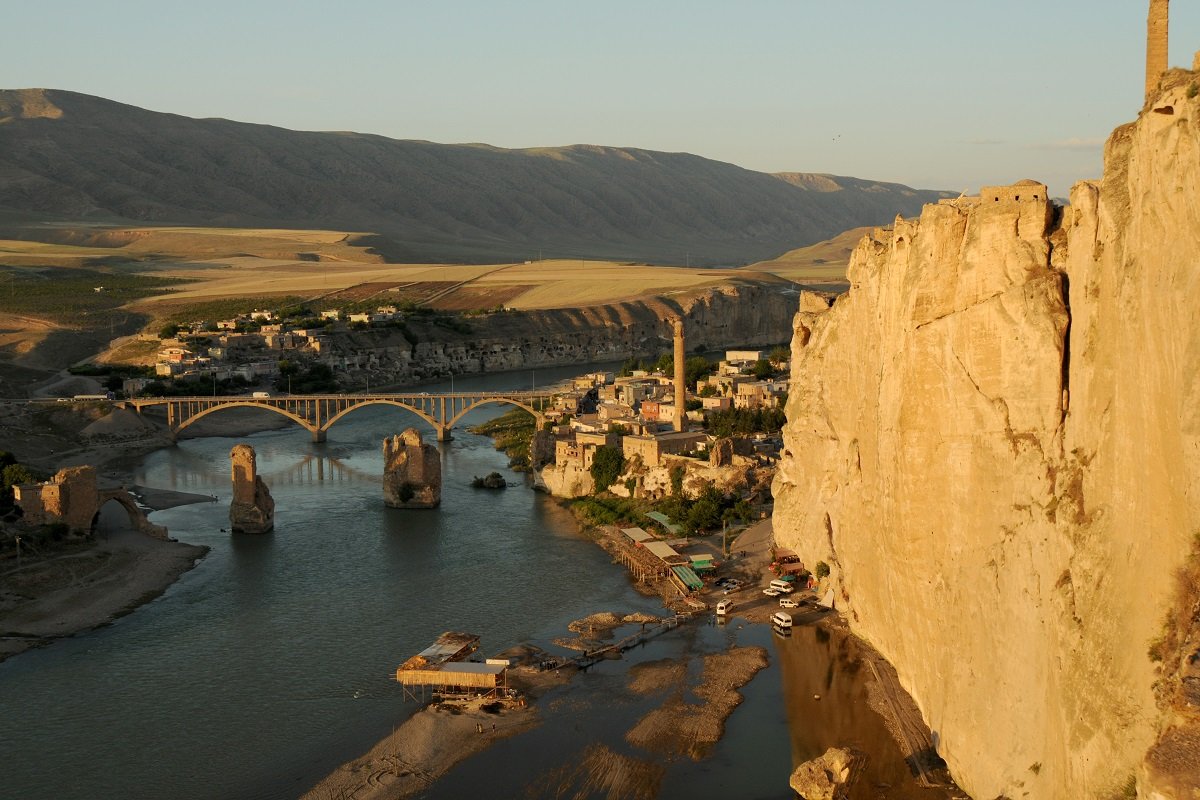
The Ilısu Dam, nearing completion in southeastern Turkey, will soon displace residents of the ancient settlement of Hasankeyf, but many of them will be ineligible for relocation and have been given nowhere to go, Deutsche Welle (DW) wrote on Tuesday.
“Neolithic caves line the surrounding cliffs, atop which a Roman citadel rises over early Ottoman minarets,” DW said in describing the area, adding that a few kilometers downstream construction on the Ilısu Dam is nearing completion and that this part of the Tigris River valley will soon become a reservoir, inundating Hasankeyf in the process. The project has been decades in the making, and despite local and international protests — in which European banks withdrew funding – recent developments suggest water levels will start rising this summer, though a firm date has yet to be announced.
Reporting that the final turbine will be installed in the 1,200-megawatt dam this spring, DW said that “To prepare, Turkey’s General Directorate of State Hydraulic Works [DSİ] issued eviction notices in February to Hasankeyf merchants, ordering them to close up shop and move to the new Hasankeyf being built across the river on higher ground.”
“The notice was met with protests. Merchants complained the new town was not yet complete and they would be unable to conduct business away from the historic sites where they have long made a livelihood from selling souvenirs to passing tourists,” DW reported.
The government has built 710 housing units in the new Hasankeyf and is allocating them only to families registered as residents of Hasankeyf. Though Merut Tekin was born and raised in Hasankeyf, he is single, so he is not eligible to purchase either housing or a commercial property in the new town. Merchants who rent shops in Hasankeyf but live in adjacent towns will also be denied property and state assistance.
“The looming project prompted Hasankeyf residents to move out over the decades, driving the town’s population down from 10,000 to about 2,000 year-round residents,” wrote DW. Citing John Crofoot, an American who has lived on and off in Hasankeyf for six years and is the co-founder of Hasankeyf Matters, which tries to raise awareness of the hamlet, the German news outlet stated that the first proposals for the Ilısu Dam were introduced in the 1950s. Since then, the prospect of a reservoir flooding the area has diverted investments away from Hasankeyf.
Over the years, Crofoot has documented developments in Hasankeyf. He said the last few months have been the most difficult for local residents. Work crews have been blasting limestone cliffs dotted with 10,000-year-old caves to fill in valleys that once operated as tourist attractions in order to rid the area of loose, potentially hazardous rocks that could collapse when water levels rise.
The state claims dynamite is not being used in the process, but residents told DW they often hear explosions coming from work areas. Large earthwork projects are also underway in Hasankeyf, one of which is meant to reinforce a cliff topped with a Roman citadel, as it will remain above the reservoir’s projected water line.
Hasankeyf residents interviewed by DW said demolition plans were never publicly shared and independent environmental impact studies had not been conducted. Such claims were refuted by Alexander Schwab, senior vice president of Andritz Hydro, the Vienna-based company overseeing the construction of Ilısu Dam. Schwab said every house in the area was tracked via aerial surveillance and later visited by consultants who informed inhabitants about the construction plans.
According to DW, Ulrich Eichelmann, CEO of Riverwatch in Vienna, disagrees. “If you destroy all this, you are in no way better than the Taliban in Bamiyam, where they destroyed the Buddha statues a few years ago,” Eichelmann said. “It’s a similar act of idiocy. It’s crazy.”
Civilized life in the ancient town of Hasankeyf dates back to the eighth century B.C., and the drawings inside the caves scattered around the town shed light on different periods, cultures and architectures of humanity. It is home to evidence of the roots of the human species, the beginning of agriculture and the beginning of civilization. The nearly 6,000 caves around the town are one of the first sites of human settlement.
With its history and nature, Hasankeyf fulfills nine of the 10 UNESCO criteria to be protected as part of the human heritage. Hasankeyf also possesses one of the richest treasures of Islamic monuments. Sitting on the banks of the Tigris River, the town is one of the most important architectural and archaeological sites in the world, boasting a rich biodiversity and 12,000 years of human history. Masterpieces of Islamic architecture, dating from the 12th to 15th centuries C.E., make the town one of the best preserved witnesses to Seljuk urban culture, particularly from the Artukid and Ayyubid dynasties.
A small town with a great heritage, Hasankeyf already attracts about 500,000 visitors each year, a number that is expected to rise. Given its historical, architectural and economic significance for the region, public opinion supports its preservation. The area was declared a First Degree Archaeological Site by Turkey’s Supreme Board of Monuments in 1978 and has been under the protection of the Culture Ministry’s General Directorate of Antiquities and Museums since 1981.
There are more than 300 archaeological sites within 7,000 hectares of land where the town settled. Eighty-three of these sites are directly affected by the dam, and the others are susceptible to the dam’s erosion affect.














